Contents
Often, when planting strawberries, the gardener does not think about which region the variety was bred for and whether it will grow well in these conditions. Therefore, sometimes failures occur when planting seemingly good planting material. It is no secret that in different parts of our large country the climate can differ dramatically. Therefore, those varieties of strawberries that are bred, for example, for the Krasnodar Territory, will be very uncomfortable in the conditions of harsh Siberia.
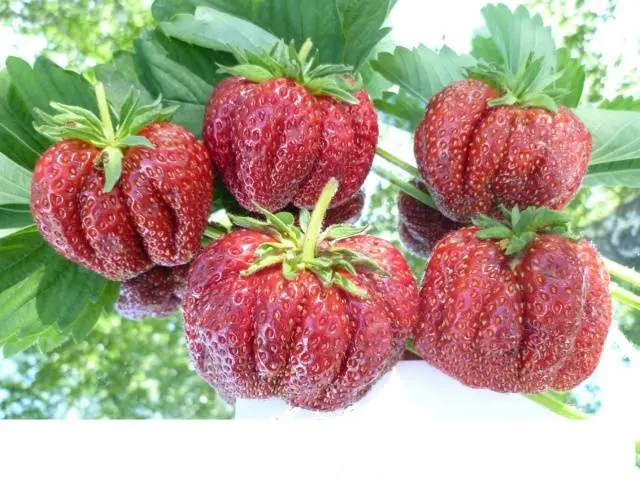
In Our Country, there is a special State Register of Breeding Achievements, in which, among other characteristics of plants, there is also a region where they should be grown. There are many varieties of strawberries or, more correctly, garden strawberries of and foreign selection. Most of them easily adapt to any growing conditions. But there are varieties intended for one specific region. These include strawberries of the First Grade variety. It is best grown in the West Siberian region, where it is zoned.
Strawberry parents First grader – Feya and Torpedo varieties. The authors of this variety are N. P. Stolnikova and A. D. Zabelina, employees of the Research Institute of Siberian Horticulture, located in Barnaul. The variety was recommended for cultivation 15 years ago.
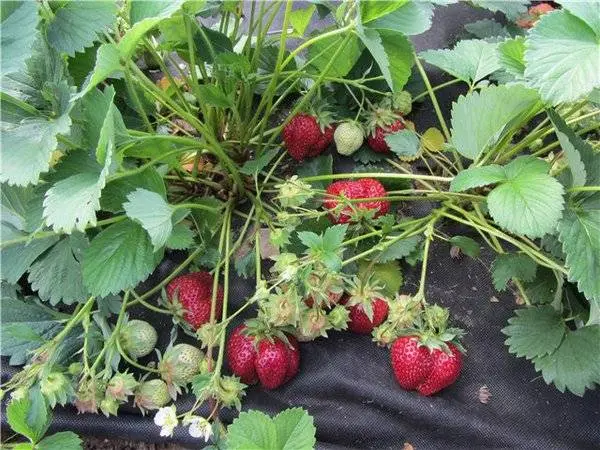
Further, the article will consider a description of the strawberry variety First-grader presented in the photo and reviews about it. According to gardeners, strawberries of this variety have a dessert taste with a slight sourness and are easy to grow, they have good yields.
Biological features of the First Grader
- The variety is not repairable.
- In terms of maturation, it belongs to medium-late. On the variety-testing plot, the first strawberries of the Pervoklassnitsa variety ripened on June 25.
- The berries reach a maximum weight of 30 g, the average weight is 10-17 g. Up to 4-5 harvests, they retain their initial size, then they become smaller without losing their taste. Strawberries of the Pervoklassnitsa variety have a tasting score of 4,5 points on a 5-point scale – a good result. The yield is 3 times higher than that of one of the parents – the Feya variety.
- The shape of the berries is rounded with clearly visible darker grooves.
- The fruiting period is extended, the number of fees can reach 7.
- Strawberry variety First grader tolerates winters and drought well. On the site where the variety was tested in the winter of 1997, at an air temperature of -33 degrees and a snow cover of only 7 cm, there was only a slight freezing of the leaves, which were easily restored in the spring, while the horns were completely preserved.
- The bush is strong, very beautiful with wavy edges of the leaves, in which the wax coating is clearly visible. It has powerful thick heavily pubescent petioles.

- The height of the bush is up to 30 cm, and the width can reach 40 cm.
- The flowers of this variety are not pure white, they have a pink-beige hue with a characteristic darker vein in the center of the petal. They are bisexual, therefore, self-pollination is possible.
- Flowering occurs in early June.
- The first grader likes to grow in the sun, but will give a good harvest in partial shade. Few varieties of garden strawberries have this feature.
- The first grader is resistant to diseases. In cold and damp summers, it can be affected by powdery mildew and white spot, but the degree of damage by these diseases is low. For powdery mildew, it is only 1 point, for comparison, this indicator for Festivalnaya strawberries is 3 points. For white spotting, the indicators are even lower – only 0,2 points.
- The purpose of this variety is universal.
- The transportability of strawberries of the First grader variety is good.
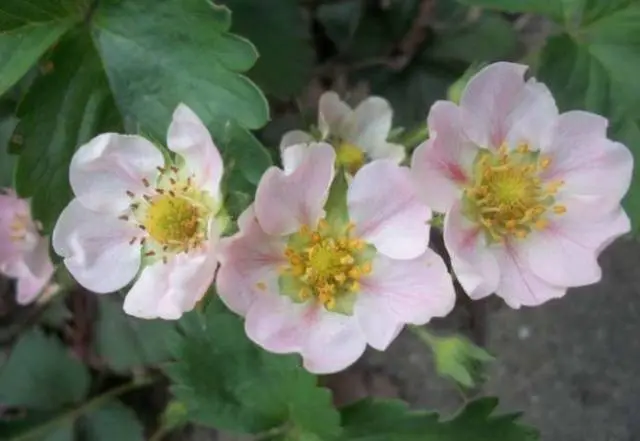
How to grow a First Grader
Proper planting and care is very important for a good harvest of garden strawberries. Each variety of strawberries has its own characteristics that must be considered when growing. For a First Grader, it is very important to choose the right landing site – in the sun or in light partial shade. So that the berries are not damaged by gray rot, damp air should not stagnate at the planting site, which contributes to the development of this disease.
This strawberry variety responds gratefully to proper care and can give a tangible increase in yield.
Reproduction
In order to get a strawberry plantation, you need to propagate it. The most common way to propagate this berry is with daughter rosettes, which gardeners call a mustache. Strawberry variety First-grader is prone to the formation of a sufficient number of well-rooted mustaches, so there are no problems with its reproduction.
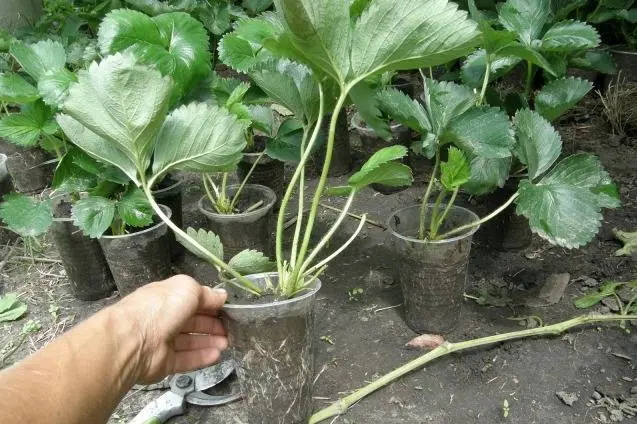
In the vast majority, they will be worse than the parent variety in terms of their performance.
By sowing seeds, only small-fruited remontant strawberries propagate. She does not have such a pattern in seed reproduction – all young plants will repeat their parents.
Planting strawberries
Planting strawberries of the First grader variety can be carried out in spring or from the second half of summer.
If this is done at a later date, the young strawberry bushes First Grader will not have time to take root and may not survive the harsh Siberian winter.
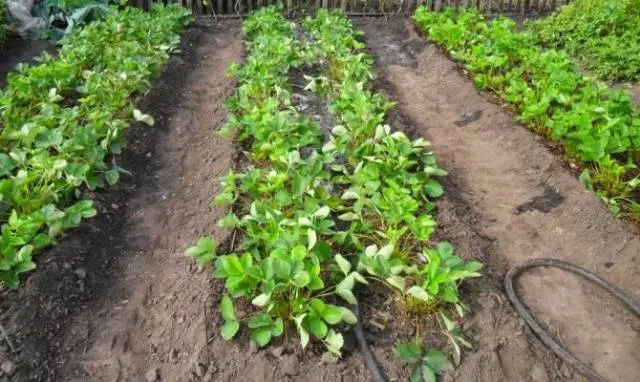
In the land prepared at least two months before planting with the addition of a bucket of humus and 50-70 g of complex fertilizer per square meter. meter planted well-rooted rosettes of strawberries no older than one year of life. Precursors of strawberry First-grader can be onions, garlic, beets, dill, parsley. Most other garden crops are not suitable for this, as they have common diseases with it.
For strawberries First grader, the best arrangement for bushes is 30×50 cm, where 30 cm is the distance between plants, and 50 is between rows. If the groundwater standing is high, it is better to plant berries on strawberries of the First Grade variety in high ridges, and if the site is dry and it rarely rains, then the beds should not be raised above ground level.

This will reduce the amount of watering, make the land more loose and fertile, prevent the berries from touching the ground, which will exclude their disease.
Black non-woven fabric is also suitable for mulching. Strawberries are planted directly into the holes made in place of the holes. The only drawback of this method of planting strawberries is that the child rosettes have nowhere to take root.

Planting holes should be filled with a handful of humus, a teaspoon of complex fertilizer and a tablespoon of ash. When planting, you need to make sure that the central kidney is not covered with earth, and the roots are completely in the soil.
Feeding
Further care for strawberries First grader also has its own characteristics. Extended fruiting requires a special regime of fertilizing and watering. Most of all, strawberries need nutrition at the following stages: at the time of leaf growth in spring, during the formation of buds and during the formation of ovaries. Since the strawberries of the First Grade variety bear fruit for a long time, one top dressing during the fruiting period is indispensable. In order not to overfeed the plants with mineral fertilizers, it is better to additionally fertilize them with organic matter. It is best to use a fermented infusion of mullein or bird droppings.
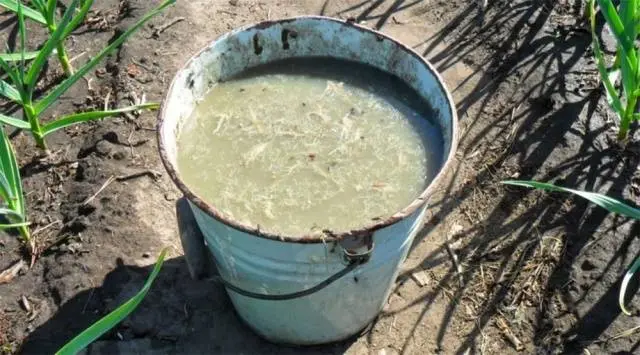
The technology for preparing mullein infusion is quite simple. A large container is half filled with fresh cow dung and topped up with water. The fermentation process lasts 1-2 weeks. Every 3 days the contents of the container are stirred.
To make it balanced, you can add ash and superphosphate to the container. On a plastic barrel with a capacity of 50 liters of fermented infusion – a liter jar of ash and 300 g of superphosphate.
When top dressing, for every 7 liters of water, add 1 liter of infusion. Application rates -10 l per sq. meter. When preparing chicken manure, the infusion is diluted more strongly.
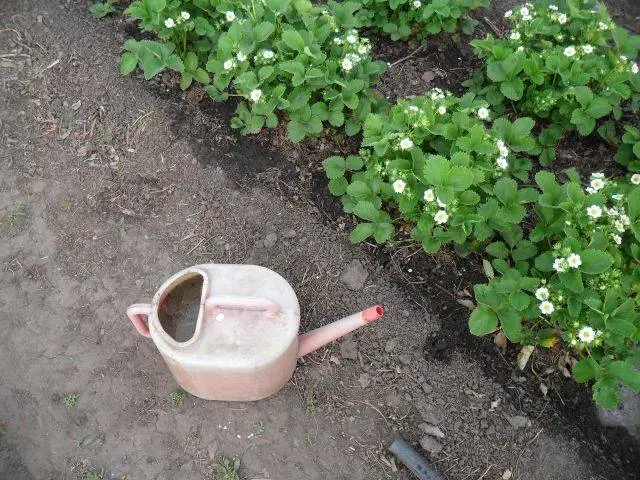
Fresh litter should be diluted with water in a ratio of 1 to 10, and dry litter 1 to 20. For feeding, 10 liter of the mixture is added for every 1 liters of water. Such a solution does not need fermentation. It is best to use it immediately after preparation.
Too concentrated a solution can burn strawberry roots.
Each organic feeding of strawberries must be combined with watering with clean water.
Watering
Strawberries are very sensitive to both excess moisture and its lack. Most of all, plants need water during the initial growing season and when pouring berries. If there is little rain at this time, strawberries need to be watered, wetting the soil well by 20 cm. It is in this layer that the main roots of this plant are located.
Loosening
This is a necessary agrotechnical technique when caring for strawberries of the First Grade variety. Due to loosening, the soil is saturated with air, the conditions for plant growth are improved. Weeds that take away food from strawberries are destroyed.
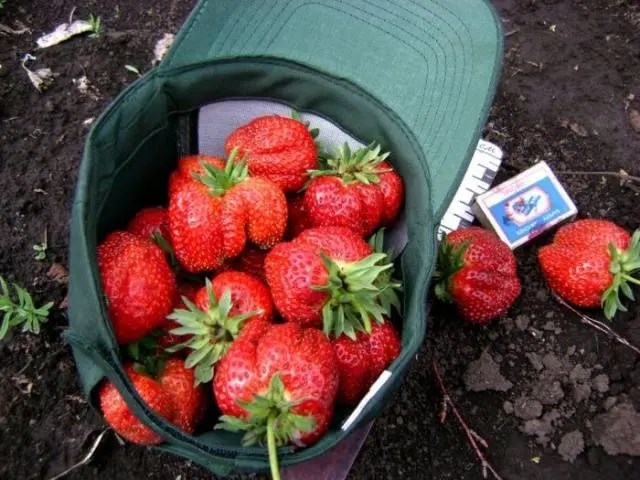
Subject to all the rules of agricultural technology, strawberries First Grader will give a rich harvest of delicious berries. And its frost resistance makes it possible to grow this useful berry even in the harsh climate of Western Siberia.










